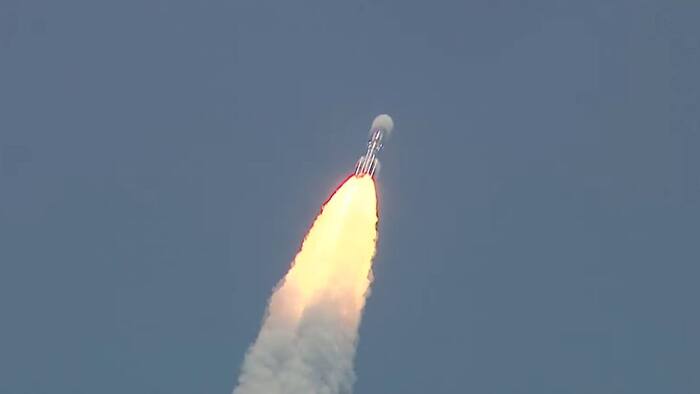
Written By Shubham Verma
Published By: Shubham Verma | Published: Sep 02, 2023, 11:58 AM (IST)

Aditya-L1, which marks the beginning of India’s third interplanetary mission and the first solar mission, kicked off with the successful liftoff of the Polar Satellite Launch Vehicle-C57 (PSLV-C57) from Sriharikota in Andhra Pradesh at the scheduled time of 11.50 am on Saturday. The PSLV-XL variant rocket carries the 1,480.7 kg Aditya-L1 spacecraft as its sole passenger that will study solar activities. Slowly rising up towards the skies with a thick orange flame at its tail, the rocket gained speed with a sound resembling rolling thunder and went up and up leaving a thick plume while the people assembled at the viewing gallery clapped their hands with pride. The Indian Space Research Organisation (ISRO) said the rocket cleared all the initial launch stages successfully to continue with the journey to reach the Lagrange Point (L1). Also Read: Rare Meteor Shower Or Satellite Debris? Delhi-Noida Sky Lights Up Overnight
“The launch of Aditya-L1 by PSLV-C57 is accomplished successfully. The vehicle has placed the satellite precisely into its intended orbit. India’s first solar observatory has begun its journey to the destination of Sun-Earth L1 point,” said ISRO after the successful launch of Aditya-L1 into its trajectory. Also Read: Gaganyaan Mission Update: ISRO Plans Half-Humanoid Vyommitra Launch Before Astronauts
Congratulating ISRO, Prime Minister Narendra Modi posted: “After the success of Chandrayaan-3, India continues its space journey. Congratulations to our scientists and engineers at @isro for the successful launch of India’s first Solar Mission, Aditya -L1. Our tireless scientific efforts will continue in order to develop better understanding of the Universe for the welfare of entire humanity.” Also Read: New Pokémon Scarlet and Violet Code Gives Players a Special Pokémon: Grab It Before June 20
After the success of Chandrayaan-3, India continues its space journey.
Congratulations to our scientists and engineers at @isro for the successful launch of India’s first Solar Mission, Aditya -L1.
Our tireless scientific efforts will continue in order to develop better…
— Narendra Modi (@narendramodi) September 2, 2023
Lagrange Point (L1) of the Sun-Earth system is about 1.5 million kilometres from the Earth. A satellite placed in the halo orbit around the L1 point has the major advantage of continuously viewing the Sun without any occultation/eclipses. This will provide a greater advantage in observing solar activities and their effect on space weather in real-time. About 63 minutes after the lift-off, the rocket will eject Aditya-L1 and the whole mission comes to an end at about 73 minutes with the passivation of the fourth stage. The Aditya-L1 spacecraft carries seven payloads, which will help the space agency observe the photosphere, chromosphere, and the outermost layers of the Sun (the corona) using electromagnetic particle and magnetic field detectors.
1. Visible Emission Line Coronagraph (VELC) – Corona Imaging & Spectroscopy
2. Solad Ultraviolet Imaging Telescope (SUIT) – Photosphere and Chromosphere Imaging- Narrow & Broadband
3. Solar Low Energy X-ray Spectrometer (SoLEXS) – Soft X-ray spectrometer: Sun-as-a-star observation
4. High Energy L1 Orbiting X-ray Spectrometer (HEL1OS) – Hard X-ray spectrometer: Sun-as-a-star observation
5. Aditya Solar wind Particle Experiment (ASPEX) – Solar wind/Particle Analyser Protons and Heavier Ions with directions
6. Plasma Analyser Package FOR Aditya (PAPA) – Solar wind/Particle Analyser Electrons and Heavier Ions with directions
7. Advantage Tri-axial High-Resolution Digital Magnetometers – In-situ magnetic field (Bx, By and Bz)